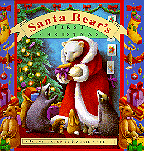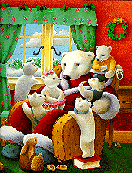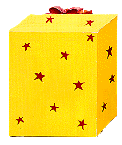


|
Santa Bear's First Christmas.
Illustrated by Maggie Kneen.
Preschool - Grade 2 / Ages 3 - 6.
|
excerpt:
``It was Christmas time, and the young bear cubs had persuaded Big Bear to dress up as Santa and hand out presents to everyone. He and his animal helpers had been very busy wrapping and carefully labelling all the gifts. But someone else had been busy too. . . Santa Bear picked up the first present, but found that the label was missing. He looked around at the other gifts. What was this? ALL the labels had disappeared!"
 Puzzle and novelty moveable books are universal children's favourites.
Combining both those features with a Christmas story should make for a
guaranteed winner. Unfortunately, clever 3-D artwork in lift-the-flap
format cannot compensate for this books' weak storyline and confusing
``mystery."
Puzzle and novelty moveable books are universal children's favourites.
Combining both those features with a Christmas story should make for a
guaranteed winner. Unfortunately, clever 3-D artwork in lift-the-flap
format cannot compensate for this books' weak storyline and confusing
``mystery."
At last Santa Bear had unwrapped all the parcels, but he was still rather puzzled about the missing labels, so he sent his animal helpers to look for them. . . . When they opened the closet doors, what a big surprise they got. All the skittles fell onto the floor! But there were no labels to be seen.
 Besides the six bowling pins, many other toys appear to fall out.
Besides the six bowling pins, many other toys appear to fall out.

Not recommended.
A. Edwardsson is in charge of the Children's Department at a branch of the Winnipeg Public Library. She has a Bachelor of Education degree and a Child Care Worker III certification, and is a member of the Manitoba branch of the Canadian Authors' Association.
If you would like to comment on this review or anything else in CM please send mail to cmeditor@mts.net
![]()
Copyright © 1995 the Manitoba Library Association.
Reproduction for personal use is permitted only if this copyright notice
is
maintained. Any other reproduction is prohibited without permission.
Published by
The Manitoba Library Association
ISSN 1201-9364
 Go back to CM Welcome page
Go back to CM Welcome page
 Go back to Table of
Contents for this Issue
Go back to Table of
Contents for this Issue